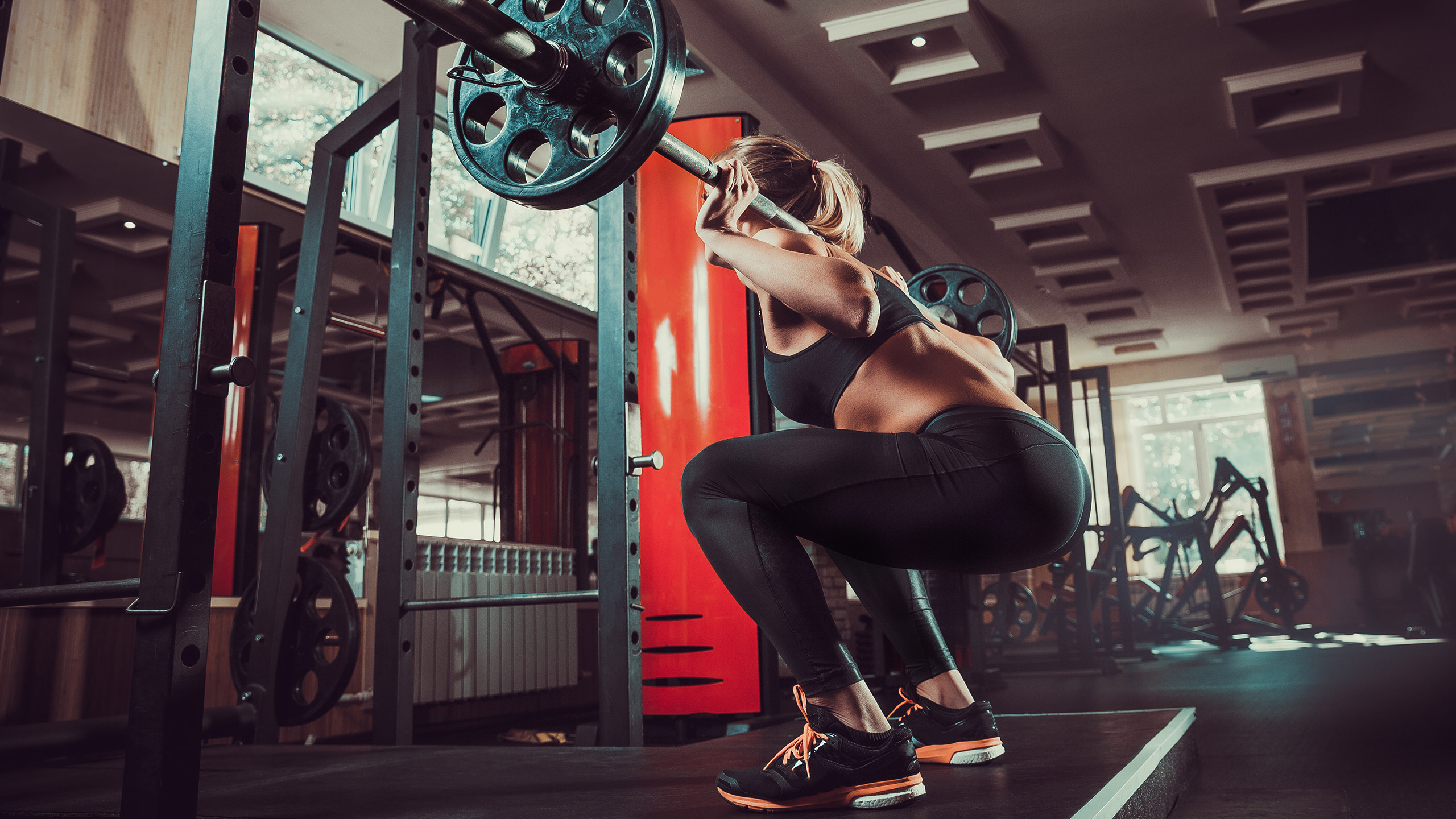Let’s get exercising! Let's start by focussing on the lower body. In this topic, you will learn how to perform and teach clients the specific exercises:
- Squats
- Lunges
- Leg presses
- Leg curls
- Leg extensions
- Calf raises
- Hip abductions
- Leg extensions
- Deadlifts.
Terminology and vocabulary reference guide
As an allied health professional, you need to be familiar with terms associated with basic exercise principles and use the terms accurately (and confidently) with clients, your colleagues, and other allied health professionals. You will be introduced to many terms and definitions. Add any unfamiliar terms to your own vocabulary reference guide.
Activities
There are several practical activities in the topic and an end of topic automated quiz. These are not part of your assessment but will provide practical experience to help you in your work and help you prepare for your formal assessment.
Throughout this topic, you will study images of each exercise and read the information on the major muscles, the equipment options, and the key coaching points and steps. You may wish to refer back to the following illustrations as you review each exercise. It is important you become comfortable with these aspects of the exercises, in a sense this information is the why, where, when, how of training. The more comfortable you become the more comfortable you will be able to make your clients when working with you.
As you describe these exercises time and time again (which you will) you will develop your own spin which works for you but first, become comfortable with the following information. Practice, practice!
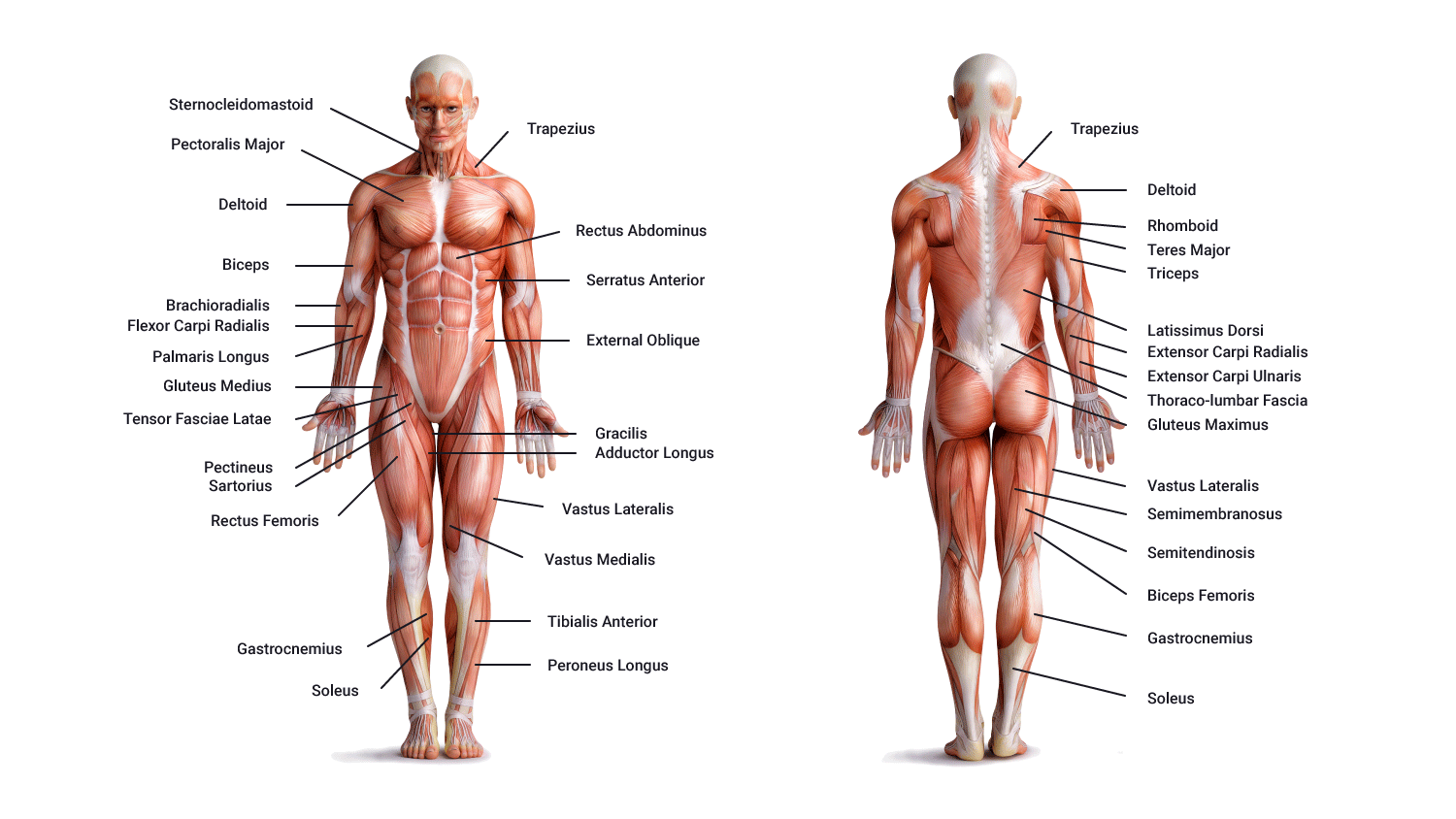
Before we get onto the exercises, let's look at some of the equipment that is commonly used.
Equipment you will probably use includes the following:
Before we look at each exercise and their specifics, let's first look at training posture. Having an awareness of our posture when we are training will lead to safe and effective exercising. This means, our bones, muscles, and joints should ideally be in their 'happy place' for optimal movement/stability/function and support.
Training posture can be described as having specific characteristics:
- Chin 'tucked in' being mindful of the cervical portion of the spine-retraction of the head. This will straighten the neck region.
- Eyes are looking straight ahead.
- Shoulders are 'back and down' (removing the rounded/shrugged shoulder posture and pulling out shoulder blades back into 'anatomical position'). This would be retraction and depression of the clavicles and scapula.
- Engage/activate the core. This is important for 'good/safe posture' when exercising as it stabilises the hips and supports the lower back along with giving the tummy muscles a 'wake up'.
- Neutral pelvis. This is important for good/safe posture' when exercising as it stabilises the hips and supports the lower back. See the image below which illustrates the neutral pelvis.
- Feet hip-width apart (typically ankles are in line with the ball and socket region of the hips). Note: This will be modified in some exercises where the shoulder-width distance of the feet is more appropriate for the exercise being performed.
- Knees in line with hips (ball and socket region) and approximately in line with middle toe.
- Feet pointing forward.
As a trainer, encourage your client to think about these points as they are performing the exercises. Some ways to activate the core include drawing in the belly button (sucking it in) as you would when on the beach and an attractive man/woman walks past (we all do it). This is also a handy way to describe this action to your client because using descriptors such as 'Activate your transverse abdominus' or 'Engage your core' will mean something to your colleagues but likely mean very little to your average client! Therefore, translating this into everyday words and something we can all relate to helps your client understands what you are asking of them (it will also ensure that when they train in their own time, they are doing it safely).
Neutral pelvis

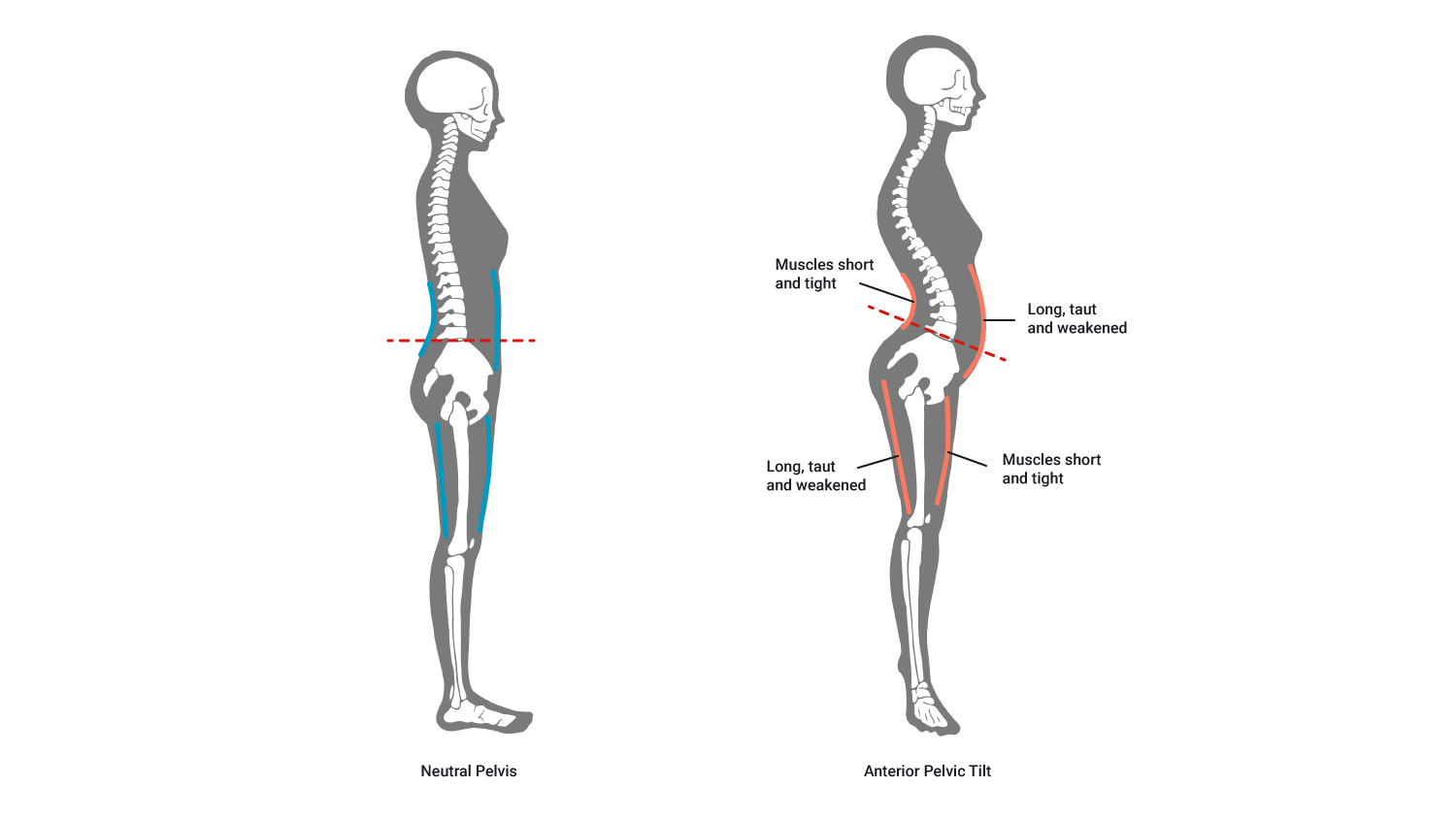
Neutral pelvis acts to ensure the posture of the lower region of the spine (lumbar and sacrum) and in their anatomical alignment, removing any 'poor posture' and ensuring the spine is efficient and safely aligned prior to and during exercise. When training, neutral pelvis can be tricky to maintain, particularly when getting tired. With this in mind, it is important to do a mental checklist of all the training posture points during an exercise and particularly between each repetition. This will soon become unconscious behaviour however in the early days, it is important to mentally run through the checklist and review each area of the body to assess if training posture is intact.
Let’s start with the squat. The images below show squats using a range of equipment options.
The following table provides information on the major muscles, variations and equipment options.
| Major muscles | Variations/progressions | Equipment options |
|---|---|---|
|
Quadriceps group Gluteal group Hamstring group Erector spinae |
Both legs One-legged Adductor squat (wide stance) Narrow squat (close stance) Front squat Overhead squat Back against the wall (with or without fitball or yoga ball) |
Freestanding Dumbbell Barbell Swissball/ fitball Machine (Smith machine) BOSU or balance trainer Sandbag |
Key coaching points and steps
- Set up by getting into 'training posture'.
- With the barbell resting on a stand, slide under the bar and place it on the trapezius.
- Pull your shoulders back and down.
- Grasp the bar firmly with the hands at a comfortable width and elbows back in line with the ribs.
- Inhale deeply, engage neutral pelvis, contract the abdominal core, look straight ahead, and remove the barbell from the stand.
- Step back one or two steps and stop with both feet parallel to each other (or toes pointed slightly out) and about shoulder-width apart, knees inline/above your ankles. Push your hips back to initiate movement and avoid rounding the back (squeeze shoulder blades and push the chest out to help).
- Aim to get thighs parallel to the floor (not necessary for all), performing a hip hinge movement whilst maintaining your core with your knees in line with your ankles as you perform the movement. Stop before the lower back begins to arch.
- Push through your heels to straighten the legs and lift the torso to return to the initial position. Ensure the knees remain 'soft' (that is, not locked or stiff).
- Exhale at end of the movement.
Squat bar variations

Note the three squat bar variations.
- The first illustration of a front squat provides more emphasis on quads, develops a strong core, and reduces stress on the lower back.
- The middle illustration of a high bar squat emphasizes a good balance of effort through quads and glutes/hamstrings.
- The last illustration of a low bar squat provides more emphasis on the posterior chain (glutes/hamstrings). It also places more stress on the lower back.
Barbell lunge
The following table provides information on the major muscles, variations, and equipment options.
| Major muscles | Variations/progressions | Equipment options |
|---|---|---|
|
Quadriceps group Gluteal group Hamstring group |
Static Alternate Dynamic (walking) Split squat (elevated/declined) Unstable surface (front leg on BOSU/balance board) |
Freestanding Dumbbell Barbell Medicine ball BOSU or balance trainer Sandbag |
Key coaching points and steps
- Aim to achieve 'training posture' as outlined above.
- Stand with a barbell on shoulders or dumbbells in hands. (Note: If using barbell, review points 1-5 as per the squat instructions).
- Inhale and take a big step forward, with training posture in place. This means core activated, neutral pelvis, shoulders back and down, looking straight ahead, knees in line with toes, and keeping torso as straight as possible.
- Lower the body until the thigh reaches parallel to the ground (client dependent) and return to the initial position. At bottom of the movement don't let knee travel over the toes, and make sure your knees don’t move too far in or out when viewed from the front.
- The bigger the step the more gluteals will be worked.
- Because all weight is supported by the front leg, the client needs a good sense of balance prior to loading. If the client appears to wobble, adjust by performing the movement slower.
- Ensure weight remains on the heel of the front foot when performing this movement, avoid weight being in the toes as this will promote the risk of injury.
If performing this exercise with dumbbells, keep these by the side of the body whilst performing the movement, if performing a barbell lunge, bring the barbell up and over the head, holding the barbell with an even distance between head and right and left hand, ensuring the elbows do not "flare" behind the body, you or your client should still be able to see their elbow in their peripheral vision easily. Once the barbell is secure and posture is set, then begin to perform the lunge movement.
-
Leg press
-
Hack squat
The following table provides information on the major muscles, variations, and equipment options.
| Major muscles | Variations/progressions | Equipment options |
|---|---|---|
|
Quadriceps group Gluteal group Hamstring group |
Double/single leg Feet high on the footplate (works glutes and hamstrings more) Feet low on the footplate (works quads more) Feet wide apart (strong use of adductors) |
Band Machine (45° plate machine or horizontal cable leg press) Hack Squat |
Key coaching points and steps
- Set up by getting into 'training posture'.
- Position the back firmly against the backrest of the machine, with feet slightly apart (typically hip-width, in line with the ball and socket region of the hips).
- Engage your core and clench your glutes.
- Inhale and release the safety bars, controlling the lowering plate of the leg rest machine as it moves with gravity. Then bend the knees completely so that the thighs touch or nearly touch the torso (or to the point where you would be unable to push the weight back).
- Return to the initial position, position, pushing through the whole foot, exhaling at the end of the movement.
- Before the next repetition, review training posture and adjust before beginning the next repetition.
Important note: People with back pain who are unable to perform squats can perform variations of this exercise which are pain-free. It is important to establish what type of back pain they may have and what exacerbates it as for some clients. The compression offered by the leg press machine can be detrimental due to the compression of the lower spine when the body is in the seated position supporting weight. This would result in the modification of the exercise to a pain-free alternative.

Machine hamstring curl
The following table provides information on the major muscles, variations and equipment options.
| Major muscles | Variations/progressions | Equipment options |
|---|---|---|
|
Hamstring group |
Feet plantarflexed (deactivates calf muscle contribution) Feet dorsiflexed (to feel effort in Gastrocnemius) Single leg Swissball leg curl |
Machine Bands Ankle weights Swiss ball |
Key coaching points and steps
- Set up by getting into 'training posture'.
- Lie facedown on the machine, holding the handles, legs extended, and ankles positioned under the ankle pads.
- Inhale, activate the core (maintaining an engaged core throughout the movement) and bend both legs at the same time, trying to touch the gluteal muscles with the heels.
- Exhale at the end of the movement.
- Return to the initial position with a controlled movement.
- Before the next repetition, review training posture and adjust before beginning the next repetition.

The following table provides information on the major muscles, variations, and equipment options.
| Major muscles | Variations/progressions | Equipment options |
|---|---|---|
|
Quadriceps |
Double leg Single leg |
Band Machine Ankle weights |
Key coaching points and steps
- Sit at machine and grasp handles or seat to hold torso immobile/stabilise the torso.
- Bend the knees and place the ankles under the ankle pads.
- Adopt the 'training posture' (chin tuck, shoulders, core, pelvis).
- Inhale and raise the legs to horizontal maintaining posture throughout the movement.
- Exhale at the end of the exercise.
- Review training posture and adjust before beginning the next repetition.
Notes
- This is the best exercise for isolating the quads.
- Recommended for beginners to develop enough strength (and to learn/adopt the movement pattern) to move onto more demanding exercises such as free weights.
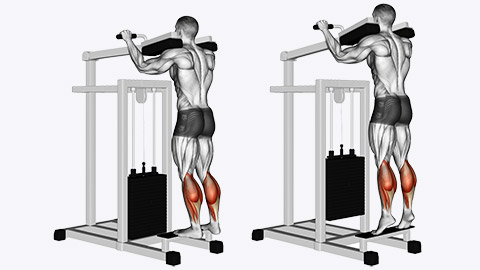
The following table provides information on the major muscles, variations and equipment options.
| Major muscles | Variations/progressions | Equipment options |
|---|---|---|
|
Gastrocnemius (emphasised in standing position) Soleus (emphasised in a seated position |
Double/single-legged Barbell/dumbbell balance Toes in (works the lateral head of gastrocnemius) Toes out (works the medial head of gastrocnemius) Seated calf raise (with bent knee soleus is prime mover) |
Machine Free weights Standing Seated with barbell |
Key coaching points and steps
- Stand at the machine with a straight back, shoulders under the pads, and balls of feet on the footplate, with calves relaxed and heels hanging down.
- Adopt 'training posture'.
- Inhale, rise up by extending (plantarflexing) the feet, keeping knees straight/soft, not 'locked' (or slight bend).
- Use a full range of motion and controlled tempo.
- Exhale, lower the heels back towards the ground, review training posture before the next repetition.
Notes
- The calf muscle group are very powerful, don't be afraid to use heavy weights with this exercise.
- Clients must train both gastrocnemius and soleus to develop a full calf.
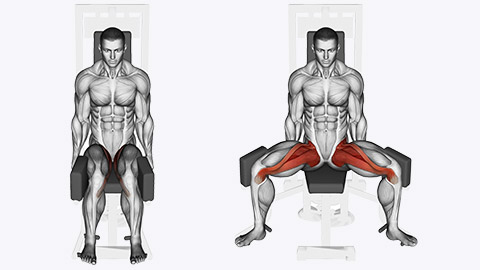
The following table provides information on the major muscles, variations, and equipment options.
| Major muscles | Variations/progressions | Equipment options |
|---|---|---|
|
Adductor group
|
Leg in neutral Externally rotate hip (toes out/in) Internally rotate hips (toes pointing in/down) |
Machine Cables Band Lying Ankle weights |
Key coaching points and steps
Machine-based exercise
- Adopt 'training posture'.
- With core engaged, place hands on machine handlebars, have thighs/knees (machine dependant) against the pads.
- Inhale and press against pads with knees/thighs and push pads away from the body (push thighs apart) in a controlled movement (that is, pushing against resistance).
- Exhale and control the movement of the thighs back together in a controlled movement (that is, controlling the weights against gravity).
- Review training posture, correct where required before performing the next repetition.
Standing cable aBduction
- Adopt 'training posture'.
- Standing with feet hip-distance apart with a cable around one leg.
- Starting position would have legs fit distance apart with cable approaching from the opposite direction (ready to offer resistance) against the outer leg (one leg when using a stable or standing machine).
- Inhale, keeping hips level (avoid 'hitching hip' up to counterbalance).
- In a smooth and straight line, move the leg away from the body, controlling the movement under resistance.
- End the movement when the hips begin to lift.
- Exhale and bring the leg back to the starting point in a controlled movement.
- Review training posture before the next repetition.
The following table provides information on the major muscles, variations, and equipment options.
| Major muscles | Variations/progressions | Equipment options |
|---|---|---|
|
Adductor group
|
Knee flexed |
Multi-hip machine Cables Band Lying Ankle weights |
Key coaching points and steps
Machine-based exercise: Seated adduction
- Adopt 'training posture'.
- With core engaged place hands on machine handlebars, have thighs/knees (machine dependant) against the pads.
- Inhale and press against pads with knees/thighs and push pads in towards the body (push thighs together) in a controlled movement (that is, pushing against resistance).
- Exhale and control the movement of the thighs back to the starting position (thighs apart) in a controlled movement (that is, controlling the weights against gravity).
- Review training posture, correct where required before performing the next repetition.
Standing cable adduction
- Adopt 'training posture'.
- Standing with feet hip-distance apart with a cable around one leg.
- Starting position would have one leg already 'abducted' (one leg if using a stable or standing machine).
- Inhale, keeping hips level (avoid 'hitching hip' up to counterbalance).
- In a smooth and straight line, move leg towards the body, controlling the movement under resistance.
- End the movement when the hips begin to lift.
- Exhale and bring the leg back to the starting point in a controlled movement.
- Review training posture before the next repetition.

The following table provides information on the major muscles, variations and equipment options.
| Major muscles | Variations/progressions | Equipment options |
|---|---|---|
|
Gluteal group Hamstring group |
Externally rotate hip |
Machine Cables Band Swissball Lying |
Key coaching points and steps
- Adopt 'training posture'.
- Ensuring core is engaged, inhale, clench glutes, and pull one leg directly behind in a straight line and in a controlled, even movement.
- Stop when the hips begin to 'hitch up' and return leg to resting position in a controlled and even movement.
- Review training posture before the next repetition.
Note: The same points apply if this exercise is performed in the upright position or laying on equipment in the prone position.
Key coaching points and steps
- Stand with legs slightly bent
- Feet should be shoulder-width apart with toes pointing forward ( or slightly outward for sumo style)
- Stand behind the bar, with the bar over the balls of your feet
- Squat down and grasp the bar with a pronated grip and the hands wider than shoulder-width
- The back should be rigid and flat, thighs parallel to the ground, eyes looking forward
- Begin raising the barbell from the floor, keeping it close to the body, slightly shifting body weight towards the heels
- Extend knees and hips at the same rate, keeping the back rigid and flat
- The shoulders should remain slightly in front or over the barbell
- The barbell should travel as close to the shins as possible, as soon as it reaches the knees. Shift body weight towards balls of the toes whilst keeping heels planted on the ground
- As the barbell continues to rise above the knees, drive the hips and gluteal muscles forward
- Whilst this is happening, retract the shoulders and keep the spine in a straight and tall position
- Lockout the deadlift and begin lowering the barbell to the ground
- Slowly push your hips back whilst keeping the spine flat (think about a proud chest)
- Slightly bend the knees once the barbell reaches them and continue to control the barbell to the floor.
In this topic, you learnt how to perform and teach clients specific exercises:
- Squats
- Lunges
- Leg presses
- Leg curls
- Leg extensions
- Calf raises
- Hip abductions
- Leg extensions
- Deadlifts.
